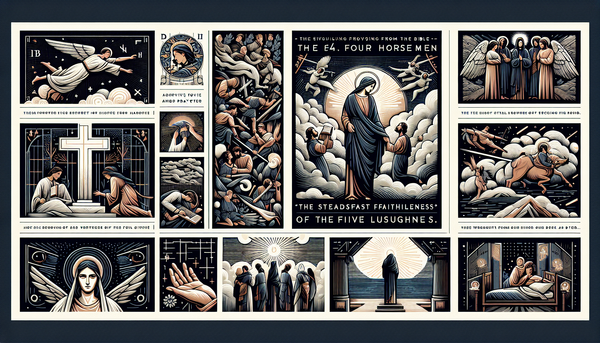In the tapestry of biblical literature, narratives that convey themes of sin, redemption, and divine communication are particularly resonant. They challenge believers to reflect on their own lives, and offer profound insights into the human condition. This article delves into the story of the adulterous woman in John 8, the foreboding vision of the Four Horsemen of the Apocalypse, the intimate act of prayer, and the essence of placing trust in God's unwavering faithfulness. Contextually related Bible verses are not merely historical records but are living words that continue to guide and shape the path of the faithful.
Table of Contents
The Story of the Adulterous Woman in John 8
The eighth chapter of John's Gospel presents a poignant scene where Jesus confronts the self-righteousness of the Pharisees with a lesson in mercy. A woman, caught in adultery, becomes the center of a test aimed at trapping Jesus between the Law of Moses and His message of forgiveness. His response, 'He that is without sin among you, let him first cast a stone at her' (John 8:7), disarms her accusers, ushering in a powerful moment of compassion over condemnation. As each accuser departs, we witness a transformative encounter where Jesus, left alone with the woman, neither condemns her nor dismisses her actions but gently urges her to a life free from sin (John 8:10-11). This narrative not only challenges us to examine our own readiness to judge but also offers a glimpse into the nature of grace that is central to the Christian faith, as echoed in Romans 8:1, 'There is therefore now no condemnation to them which are in Christ Jesus...'
The Four Horsemen of the Apocalypse
Revelation's apocalyptic literature paints a vivid portrait of the end times, where the Four Horsemen stand as harbingers of cataclysmic events. The first, a White Horse whose rider holds a bow and is crowned, rides forth as a conqueror (Revelation 6:2), symbolizing either conquest or pestilence. The Red Horse follows, its rider granted a large sword to strip the earth of peace, signifying the onset of war (Revelation 6:4). Famine rides upon the Black Horse, with scales in hand, illustrating a time of scarcity where basic necessities become luxuries (Revelation 6:5-6). Lastly, the Pale Horse emerges, its rider named Death, followed closely by Hades, representing the inevitable end that comes to all (Revelation 6:8). These figures are not just portents of doom but serve as a reminder of the trials that humanity may face and the final judgment that awaits.
Prayer and Communication with God
Prayer, as presented in the Holy Scriptures, is a multifaceted practice encompassing adoration, confession, thanksgiving, and supplication. It is an open line of communication with the Divine, where believers are encouraged to 'pray without ceasing' (1 Thessalonians 5:17). In the privacy of one's closet or the openness of a communal setting, prayer offers a means to share daily experiences and seek guidance, as well as to listen for God's voice. The act of prayer is less about the ritual and more about cultivating a relationship with God, where the heart speaks and the soul listens. As we navigate through life's complexities, the practice of prayer as depicted in Philippians 4:6, 'Be careful for nothing; but in every thing by prayer and supplication with thanksgiving let your requests be made known unto God,' becomes an essential tool for spiritual growth and inner peace.
Conclusion
Our journey through these biblical themes reveals a tapestry rich with lessons on human frailty, divine grace, and the promise of redemption. From Jesus' compassionate response to the adulterous woman, to the symbolic Four Horsemen heralding the trials of the end times, and the deep communion found in prayer, these stories offer guidance for our spiritual walk. Trusting in God's faithfulness is the thread that binds these narratives, reminding us that amidst life's tumult, there is a steadfast anchor. As we reflect on these passages, we are invited to deepen our understanding and strengthen our relationship with the Divine, finding solace in the eternal words of Scripture.
FAQ
Q: Is praying and talking to God different?
A: Prayer encompasses a wide range of spiritual practices, including talking to God, which is often conversational and personal, as well as listening for His guidance. It is an integral part of one's relationship with the Divine, as depicted in scriptures like 1 Thessalonians 5:17, which instructs to 'pray without ceasing.'
Q: What are the four horsemen?
A: The Four Horsemen are symbolic figures in the Book of Revelation, representing conquest or pestilence (White Horse), war (Red Horse), famine (Black Horse), and death (Pale Horse). They appear in Revelation 6:1-8 and are part of prophetic visions concerning the end times.
Q: Blessed are those who hunger for righteousness?
A: This beatitude from Matthew 5:6 underscores the spiritual longing for righteousness and justice, promising that such individuals will be satisfied. It speaks to the value of pursuing moral integrity and divine truth.
Q: What happens in John chapter 8?
A: In John chapter 8, Jesus encounters a woman accused of adultery. He challenges the accusers' self-righteousness and extends forgiveness to the woman, affirming, 'Neither do I condemn thee: go, and sin no more' (John 8:11). The chapter continues with discussions on truth, freedom in Christ, and spiritual lineage.




